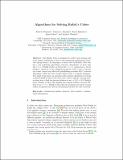| dc.contributor.author | Demaine, Erik D. | |
| dc.contributor.author | Demaine, Martin L. | |
| dc.contributor.author | Eisenstat, Sarah Charmian | |
| dc.contributor.author | Lubiw, Anna | |
| dc.contributor.author | Winslow, Andrew | |
| dc.date.accessioned | 2012-10-10T15:43:42Z | |
| dc.date.available | 2012-10-10T15:43:42Z | |
| dc.date.issued | 2011-08 | |
| dc.date.submitted | 2011-09 | |
| dc.identifier.isbn | 978-3-642-23718-8 | |
| dc.identifier.issn | 0302-9743 | |
| dc.identifier.issn | 1611-3349 | |
| dc.identifier.uri | http://hdl.handle.net/1721.1/73771 | |
| dc.description | 19th Annual European Symposium, Saarbrücken, Germany, September 5-9, 2011. Proceedings | en_US |
| dc.description.abstract | The Rubik’s Cube is perhaps the world’s most famous and iconic puzzle, well-known to have a rich underlying mathematical structure (group theory). In this paper, we show that the Rubik’s Cube also has a rich underlying algorithmic structure. Specifically, we show that the n ×n ×n Rubik’s Cube, as well as the n ×n ×1 variant, has a “God’s Number” (diameter of the configuration space) of Θ(n [superscript 2]/logn). The upper bound comes from effectively parallelizing standard Θ(n [superscript 2]) solution algorithms, while the lower bound follows from a counting argument. The upper bound gives an asymptotically optimal algorithm for solving a general Rubik’s Cube in the worst case. Given a specific starting state, we show how to find the shortest solution in an n ×O(1) ×O(1) Rubik’s Cube. Finally, we show that finding this optimal solution becomes NP-hard in an n ×n ×1 Rubik’s Cube when the positions and colors of some cubies are ignored (not used in determining whether the cube is solved). | en_US |
| dc.language.iso | en_US | |
| dc.publisher | Springer Berlin / Heidelberg | en_US |
| dc.relation.isversionof | http://dx.doi.org/10.1007/978-3-642-23719-5_58 | en_US |
| dc.rights | Creative Commons Attribution-Noncommercial-Share Alike 3.0 | en_US |
| dc.rights.uri | http://creativecommons.org/licenses/by-nc-sa/3.0/ | en_US |
| dc.source | MIT web domain | en_US |
| dc.title | Algorithms for solving rubik's cubes | en_US |
| dc.type | Article | en_US |
| dc.identifier.citation | Demaine, Erik D. et al. “Algorithms for Solving Rubik’s Cubes.” Algorithms – ESA 2011. Ed. Camil Demetrescu & Magnús M. Halldórsson. LNCS Vol. 6942. Berlin, Heidelberg: Springer Berlin Heidelberg, 2011. 689–700. | en_US |
| dc.contributor.department | Massachusetts Institute of Technology. Computer Science and Artificial Intelligence Laboratory | en_US |
| dc.contributor.department | Massachusetts Institute of Technology. Department of Electrical Engineering and Computer Science | en_US |
| dc.contributor.mitauthor | Demaine, Erik D. | |
| dc.contributor.mitauthor | Demaine, Martin L. | |
| dc.contributor.mitauthor | Eisenstat, Sarah Charmian | |
| dc.relation.journal | Algorithms – ESA 2011 | en_US |
| dc.eprint.version | Author's final manuscript | en_US |
| dc.type.uri | http://purl.org/eprint/type/ConferencePaper | en_US |
| dspace.orderedauthors | Demaine, Erik D.; Demaine, Martin L.; Eisenstat, Sarah; Lubiw, Anna; Winslow, Andrew | en |
| dc.identifier.orcid | https://orcid.org/0000-0003-3803-5703 | |
| dc.identifier.orcid | https://orcid.org/0000-0002-3182-1675 | |
| mit.license | OPEN_ACCESS_POLICY | en_US |
| mit.metadata.status | Complete | |
